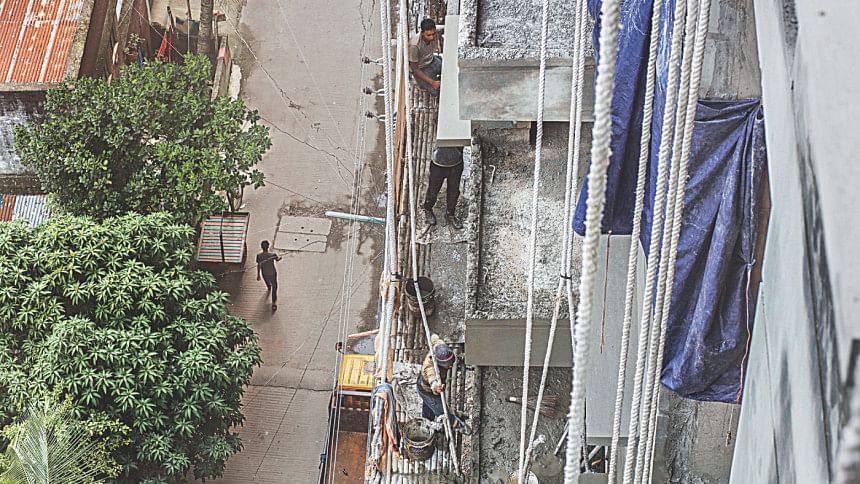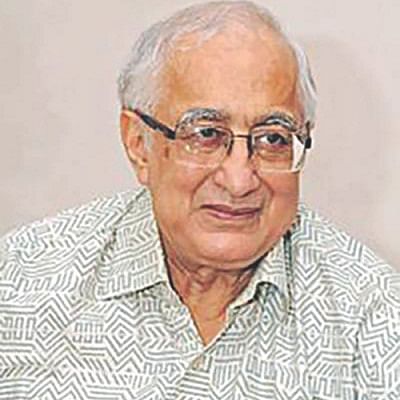‘We have a long way to go to ensure construction of buildings which satisfy all the requirements of the National Building Code’

How has the quality of construction evolved in Bangladesh over the years?
It is very difficult to generalise the quality of construction in Bangladesh. There are some buildings which have been designed as per the building code and constructed with materials which fulfill the requirements of specifications in different related standards.
First of all, the term "construction" encompasses different types of structures including buildings, roads, bridges and other industrial structures. I will try to focus on buildings only. Among buildings, there are different types of construction which may be broadly classified under two categories, viz. "engineered" buildings and "non-engineered" buildings (built with, for example, bricks, mud walls, corrugated sheets roofs/walls, bamboo walls, bamboo/timber/precast concrete posts). In fact, when it comes to housing throughout the whole country, I still think houses with Corrugated Galvanised Iron (CGI) sheet supported on bamboo/concrete posts are still very common. The major problem with this type of structure is that when they are subjected to high winds, for example, during cyclones, nor 'westers, the roofs are blown away due to high suction forces and collapse sideways. Over the years, improvements have been made in the construction details so that these houses can be made more durable.
The next popular type of construction is buildings which use burnt clay brick masonry for the supporting wall with reinforced concrete roof slabs. These are more durable against winds but in case of earthquakes, there is a risk for these buildings to collapse if these walls are not reinforced. In our building code, guidelines have been given on how to make these un-reinforced brick masonry structures better resist earthquake forces. Unfortunately, these guidelines in our building code are rarely followed in practice. In urban areas, many buildings are constructed using reinforced concrete beam-column frame system. Again, many of these buildings are being constructed without following the guidelines of the National Building Code. Many of the owners of buildings don't use the services of qualified engineers in design or construction. With the increasing popularity of multi-storied buildings, not only in urban areas, but also in some rural areas, the structures are being built without following the provisions of the building code. Many owners think that involvement of qualified engineers is likely to lead to significant increase in the construction cost. However, this isn't true. There may be a very small increase in cost, but the safety of the structures which will be ensured by following the National Building Code will lead to a more durable and safe structure.

In reinforced concrete construction, it is very important that the cement and steel which are used fulfill the requirements of specifications. Mixing of cement with sand and stones or brick chips in proper proportions with measured quantity of water is extremely important; moreover, after placement of concrete, the proper method of compaction and curing is extremely important. Unfortunately, many of the building craftsmen such as masons lack adequate knowledge about the role of water in ensuring quality of concrete and go on adding water to make it easier for them to pour the concrete without realising that adding extra water may lead to very weak concrete. Similarly, the quality of steel, particularly made from scrap, is also sub-standard and does not fulfill the requirements of specifications. Overall, over the years, some improvements have been made but we have quite a long way to go in ensuring that any building which is constructed, satisfies all the requirements of the National Building Code.
What are the construction standards both in rural and urban areas for big and small construction projects? Is there any authority who monitors the standards of construction? What are the standards of materials in saline-prone zones?
The Bangladesh National Building Code (BNBC) was published by HBRI and BSTI in 1993 but it was officially published as a gazette notification in November 2006. As per the prevailing Building Construction Act, the regulatory authorities for enforcing the building code for various areas of the country have been specified. For example, for Dhaka city, RAJUK has been named as the regulatory authority. Similarly, for other metropolitan areas, the development authorities such as CDA in Chattogram and KDA in Khulna have been given the responsibility. In Sylhet City, Sylhet City Corporation is the designated authority. In rural areas, Union Councils are supposed to approve the construction. A few years back, the Honourable High Court gave a directive to the government to establish a separate authority whose responsibility would be to enforce the building code throughout the whole country.
Efforts to update the building code were initiated in 2010 and the responsibility was given by the Bangladesh government to BUET to prepare the draft, reflecting the recent developments which have taken place in design and construction methodology.
It is worth mentioning that in most other countries, building codes are updated every three to five years. Although the new version of building code has been ready since around 2013, the government is yet to finally give its seal of approval and start implementing it. The new building code includes a chapter on the building regulatory authority (as directed by the Honourable High Court).
The building code includes special measures for the types of materials (e.g. steel, cement, brick, sand) that should be used in saline-prone zones, where the risk of corrosion of steel reinforcements and other materials is relatively high. The use of sub-standard materials and weak concrete in coastal regions has led to such structures becoming unusable within a few years after construction and sometimes premature failure of steel as well as reinforced concrete structures.
What are the challenges in ensuring safe construction and how can they be overcome? Sometimes, even when standard materials are used, they are not utilised in the right manner (for example, not knowing the right way of making concrete). How can this problem be solved?
Many of the building technicians at the field level are not familiar with the right way of making concrete. The only way this problem can be solved is to launch a country-wide programme to train various levels of building technicians, for example, masons and rod binders. A long-term solution may be introducing certifications of such technicians involved in various vocational trades. Some progress has been made, for example, by initiating a training programme through projects funded by Asian Development Bank (ADB) and being implemented by Bangladesh Association of Construction Industry. The availability of such trained manpower in large numbers will not only help in ensuring better quality construction but also help in the export of skilled personnel to other countries.
In order to ensure the structures are safe during construction, throughout its lifecycle and also to ensure safety during demolition, the provisions of the building code must be strictly enforced throughout the whole country. It's a big challenge but with strong political will and by strengthening the regulatory authorities which are responsible and increasing awareness among the owners of buildings, it should be possible to make the built environment in Bangladesh much safer. Unfortunately, ensuring that structures remain safe throughout the whole lifecycle via regular maintenance and continuous inspection is not being practised in Bangladesh. This has been a major cause for tragic failures leading to loss of human lives.
What precautions can we take regarding the standards of materials for ongoing and future construction? How can we meet international standards?
First of all, the building materials which are used in construction must be sourced from suppliers who have proper certification for the quality of products. BSTI, which has been entrusted by the government to ensure this, must carry out regular monitoring of all such products being manufactured by the large number of factories. Similarly, the users must be familiar with the process and insist that all the suppliers produce the results of these tests from reliable laboratories (e.g. HBRI, BUET or other universities with civil engineering departments which have already established a reputation for reliability). Most of the materials that we use in construction require satisfaction of specifications which are based on international standards. BNBC is also based on similar codes in other countries except in some provisions which are based on local conditions. For example, we have our own seismic zoning map which is based on analysis of past records and tectonic features. The wind map, storm surge map and the rainfall map are also based on analysis of local data.
How can we ensure the longevity of existing structures? How can we prevent accidents and be more prepared to tackle calamities such as an earthquake?
Every structure requires regular maintenance. Unfortunately, the culture of maintenance doesn't exist in Bangladesh. One example is not noticing the growth of plants with the roots in the cracks in buildings. As the roots of the plants spread in the structure, forces are generated which widen the cracks and seepage of water occurs, and if this continues for years, the building may collapse. Accidents can be prevented by regular inspection and taking appropriate measures. Some of the recent accidents originating from fires have their origins not only in lack of safety measures in design and construction but also in the negligence of the owners in ensuring that the fire exits and stairs are properly maintained.
In case of an earthquake, a pre-requisite is ensuring the proper design and construction, particularly in the proper detailing of reinforcement. Earthquakes usually last for a very brief period (20 to 30 seconds); so, it wouldn't be possible for the building occupants to exit the building right after they start feeling the earthquake. Therefore, it is extremely important that the structure is designed and detailed as per the building code.
How can we make safe construction more affordable?
There are guidelines for low-cost construction of non-engineered housing. I was involved in preparing manuals for wind resistant housing as well as earthquake resistant housing which are easily understandable by building technicians; they do not require significant additional expenses. For wind, it requires stronger fixing with the supporting structure and for earthquakes, the structure should be made more ductile (to make it absorb greater horizontal movement without collapsing).
The interview was taken by Maisha Zaman of The Daily Star.

 For all latest news, follow The Daily Star's Google News channel.
For all latest news, follow The Daily Star's Google News channel. 



Comments